![]() 21 - 23 September 2009
21 - 23 September 2009
New Forest, UK
Overview
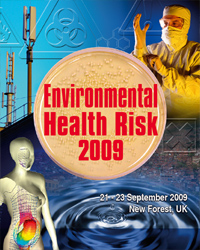
The fifth International Conference on the Impact of Environmental Factors on Health (E.H.R 2009) has recently taken place at the Ashurst Lodge campus of the Wessex Institute of Technology.
Health risks resulting from environmental effects are a major source of concern all over the world. The conference attracted a substantial number of researchers and participants involved in the assessment of the risks resulting from environmental factors, including those related to quality of the air, water, soil, food and many others.
The aim of the conference is to help establish measures to protect society’s health, either by eliminating or remedying the hazardous factors. Achieving this aim is complicated by the emergence of new factors and processes, many of which produce unexpected side effects. Partially because of this the conference objectives have evolved over the years to encompass new topics and fields of active research.
Environmental Health Risk is a global problem and one that needs to be studied and solved by international cooperation. In this regard, the representation of many different countries and regions of the world at the meeting was most positive as it indicated the willingness of the international scientific community and other authorities to find ways of collaborating.
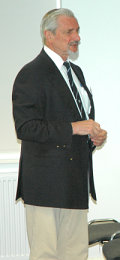 Professor Carlos Brebbia, Director of WIT and chairman of the conference, opened the meeting by explaining the objectives of his Institute. He stressed that WIT is committed to the transfer of knowledge at an international level and with special emphasis on linking the physical sciences with those more directly related to Society. This, he hopes, will lead to finding appropriate solutions to the many environmental and ecological problems affecting the world today.
Professor Carlos Brebbia, Director of WIT and chairman of the conference, opened the meeting by explaining the objectives of his Institute. He stressed that WIT is committed to the transfer of knowledge at an international level and with special emphasis on linking the physical sciences with those more directly related to Society. This, he hopes, will lead to finding appropriate solutions to the many environmental and ecological problems affecting the world today.
Carlos described some of the recent projects carried out at WIT which could be of interest to the participants, including those related to toxic and nuclear waste, food contamination, electromagnetic radiation and others. He mentioned that at the Institute has numerous links and programmes with other institutions and welcomes further collaboration in different areas.
The conference book as well as other publications are now being distributed in digital as well as paper format. This is a new development which complements the other very successful eLibrary of the Wessex Institute (http://library.witpress.com) which archives all past papers presented at WIT conferences since 1993. A further development is the launching of an International Journal, complementing those already published by WIT. This is the International Journal of Safety and Security. Carlos welcomes papers for this new publication which deals with a wide variety of topics.
Conference Topics
Papers presented at the meeting and published in the conference book were divided into the following topics:
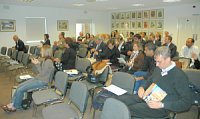 Air Pollution
Air Pollution- Water and Soil Quality
- Occupational Health
- Risk Prevention and Monitoring
- Toxicology Analysis
- Ecology and Health
- Food Safety
Invited Presentations
There was also a series of special presentations by invited speakers including:
- “Risk analysis of Volatile Organic Compounds using their indoor diffusion characteristics” by T. Oyabu, Kanazawa Seikyo University, Japan
- “Indoor concentrations of PM2.5 in day care centres” K, Rumchev, Curtin University of Technology, Australia
- “Influence of the vinasse application in sugar cane fields in Patrocinio Paulista, São Paulo State, Brazil” by D. M. Bonotto, University of São Paulo State, Brazil
- “Acute toxicity of lead nitrate to red swamp crayfish procambarus clarkia” by P. B. Tchounwou, Jackson State University, USA
- “Depeleted uranium and public health risks in the Balkan region” F. P. Carvalho, Instituto Tecnologico e Nuclear, Portugal
Special Presentation By Kirsty Duncan
There was a special presentation by Kirsty Duncan, from the University of Toronto and a member of Parliament in Canada. The presentation was on DVD as her parliamentary duties forced her to cancel her travelling plans at the last minute.
Dr Duncan is a renown specialist in the field of pandemics. She led the expedition to discover the causal agent of the 1918 “Spanish influenza” virus. She describes in a book the details of the ten-year history of the search.
Dr Duncan graduated at the University of Toronto with a bachelors degree in Geography and Anthropology and completed her PhD at the University of Edinburgh. She worked for the University of Windsor and taught at the Rotman School of Management and Royal Roads University. She is currently Associate Professor in Health Studies at the University of Toronto.
Her second book “Environment and Health: Protecting our common future” was recently published by WIT Press (ISBN: 978-1-84564-130-6).
She completed work regarding climate change and human health for North America for the Intergovernmental Panel on Climate Change (IPCC), the well-known joint venturee of the United Nations Environmental Programme and the World Meteorological Organization.
Prior to being elected as an MP, she sat on the Advisory Board for Pandemic Flu for the Conference Board of Canada and was helping different organisations throughout the United States and Canada.
Her presentation dealt with two of the dangers facing society, with particular reference to Pandemics and Climate Change.
Social Activities
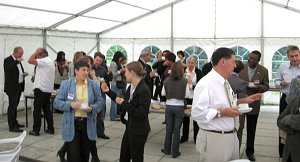 There were many opportunities for the participants to hold discussions and increase personal contacts in informal settings. They had lunch as well as coffee breaks together and were offered guided visits of local sites.
There were many opportunities for the participants to hold discussions and increase personal contacts in informal settings. They had lunch as well as coffee breaks together and were offered guided visits of local sites.
During the first day they visited Bucklers Hard in the New Forest. This is a very picturesque site of historical interest. Ships were built there for nearly 100 years with oaks from the New Forest.
At its height there were five slipways and around 20 cottages in the village. Only two rows of cottages now remain with a broad village street separating them and sloping towards the river. At the end of one of these now stands a hotel, which was the mater builder’s house, and one of the builder’s cottages is now a tiny chapel. An excellent display at the entrance of the village describes the activities that took place.
Many wooden ships were built there including the famous Agamemnon, commanded by Nelson during the siege of Calvi, where he lost the vision in his right eye, together with the Swiftsure and Euryalus, all built at Bucklers Hard, took part in the Battle of Trafalgar.
The weather was kind during their visit and the participants were able to enjoy the unique sights and scenery.
After lunch on the second day they were given a guided tour of the main building at Ashurst Lodge, where the research activities take place. They were also shown the departments related to WIT Press, the publishing arm of the Institute.
International Scientific Advisory Committee Meeting
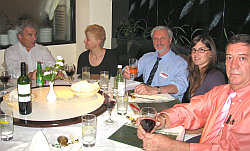 The International Scientific Advisory Committee of the conference met at a local restaurant over dinner. The scope of the conference was discussed as well as ways in which the conference could be better promoted, aiming to increase the quality of the presentations. Other topics were discussed for possible inclusion in the conference programme. There was general agreement that the conference was very successful and ought to be reconvened in 2011, in a place to be announced shortly.
The International Scientific Advisory Committee of the conference met at a local restaurant over dinner. The scope of the conference was discussed as well as ways in which the conference could be better promoted, aiming to increase the quality of the presentations. Other topics were discussed for possible inclusion in the conference programme. There was general agreement that the conference was very successful and ought to be reconvened in 2011, in a place to be announced shortly.
Conference Dinner
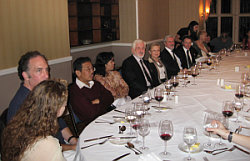 The conference dinner took place in a large Manor House in the New Forest, called Rhinefield House, now an excellent hotel. This was one of the residences of the Master Keeper until the end of the 19th century it was sold to a family who owned collieries in Nottingham. They then started to rebuild the house.
The conference dinner took place in a large Manor House in the New Forest, called Rhinefield House, now an excellent hotel. This was one of the residences of the Master Keeper until the end of the 19th century it was sold to a family who owned collieries in Nottingham. They then started to rebuild the house.
The house has the aspect of a neo-gothic castle and consists of a series of large reception rooms and apartments. It was sold in the 1950’s and different enterprises were accommodated there without much success until the 1970’s when it was restored and started to function as a hotel.
The most impressive room in the house is the great hall with a hammer-beam roof resembling the one in Westminster Hall in London. In keeping with the variety of styles in the house, the dining room is beautifully paneled with a large carving on the mantelpiece representing the defeat of the Spanish Armada. Other smaller rooms are decorated in Italian and French styles, the most surprising is a small room decorated in a style resembling the Alhambra palace in Granada.
The beautiful settings were fit for the excellent cuisine and good wines offered during the banquet.
Close of the Conference
The conference ended with a barbeque in the grounds of the Institute, and the pool and relaxation areas. The excellent food helped contribute to the friendliness of the occasion, in which delegates and some research staff of the Institute participated as well as the delegates of an associated meeting on Disaster Management. It was a most fitting way to end one of the nicest and friendly conferences ever organized by WIT.Publication of Papers
 The proceedings of Environmental Health Risk V, 432pp (Print ISBN: 1-84564-201-3; On-line ISBN: 1-84564-378-2; Print ISSN: 1747-4485) are available from WIT Press priced at £164/US$295/€213. Orders can be placed by telephone: +44 (0) 238 029 3223, fax: +44 (0) 238 029 2853, e-mail: This email address is being protected from spambots. You need JavaScript enabled to view it. or via the WIT Press web site at www.witpress.com
The proceedings of Environmental Health Risk V, 432pp (Print ISBN: 1-84564-201-3; On-line ISBN: 1-84564-378-2; Print ISSN: 1747-4485) are available from WIT Press priced at £164/US$295/€213. Orders can be placed by telephone: +44 (0) 238 029 3223, fax: +44 (0) 238 029 2853, e-mail: This email address is being protected from spambots. You need JavaScript enabled to view it. or via the WIT Press web site at www.witpress.com
Papers from the conference will also be hosted online at the WIT eLibrary as volume 14 of WIT Transactions on Biomedicine and Health (On-line ISSN: 1743-3525). For more details visit the WIT eLibrary at www.witpress.com
The New Forest: A Personal View, by C.A. Brebbia, 128pp (ISBN 1-84564-145-0) is available in hard back from WIT Press, priced at £19.50/US$39/€26. Orders can be placed as above.


 Wessex Institute
Wessex Institute